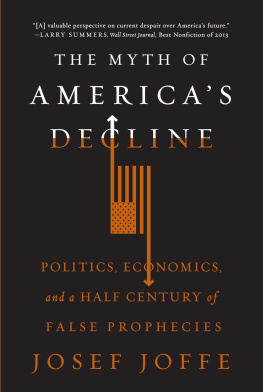
ALSO BY Josef Joffe
______________________
berpower: The Imperial Temptation of America
The Future of the Great Powers
The Limited Partnership: Europe, the United States,
and the Burden of Alliance
Ending Empire (coauthor)
The Political Role of Nuclear Weapons: No-First-Use
and the Stability of the European Order

To Samuel P. Huntington
teacher, friend, and giant among his peers
TABLES
FIGURES
_______________________
D ecline is as American as apple pie, the theme antedating the birth of the American Republic. Already before the founding, America was doomed, as some towering figures of the French Enlightenment claimed. Even the animals were smaller on this huge continent. The title of a book by Georges-Louis Leclerc de Buffon, De la dgnration des animaux (1766), tells it all. Another early critic targeted the pernicious climate of the New World, reporting on a people who were astonishingly idiotic, enervated, and vitiated in all the parts of their organism. Americans were both feeble and feebleminded. European settlers were degenerating with every successive generation. Youthful vigor would run out of steam before these Anglo-Americans had reached maturity; hence they faced but decrepitude and old age.
Mainly homemade, the modern version originated in the America of the 1950s, when Decline 1.0 came to grip the land. The drama has been reenacted about once every decade, the most recent waveDecline 5.0rising in the first decade of the present century. The trigger was always reala brutal recession or a geopolitical setback. Yet each time, crisis spelled foreordained doom, a fate insistently painted on the countrys wall by Americans rather than by foreign observers. Either there was something fundamentally wrong with this New World, or other nations were bettermore ambitious, capable, and dynamic. The starring candidates changed, or returned to center stage, from decade to decade. The first was the Soviet Union; it was followed by Europe, Japan, and most recently Chinawith other unstoppable risers like India trailing right behind.
This author remembers the first wave of Declinism, also known as Sputnik Shock, only dimly. Yet in retrospect, the late 1950s came to stand out as premiereas Decline 1.0, the first instance of a recurring phenomenon. As a student in the United States, the author took part in Decline 2.0. He lived through the turmoil of the late 1960s and early 1970s, participating, as his generation did, in the civil rights and antiwar upheavals that scarred and transformed the nation. He observed Declines 3.0 and 4.0 from abroad. First, it was the Carter malaise, then the rise of Japan and the resurgence of the Soviet Union.
These acts in the never-ending drama offered particularly rich evidence in support of the Declinist thesis. As Japan threatened to overtake the United States economically, while Soviet Russia was again forging ahead strategically, the United States was sinking fast on both accounts. Declinism took a break in the 1990s, but only to return with a vengeance in the 2000s. Now, with the author teaching U.S. foreign policy at Stanford, China was going to dethrone the reigning superpower, propelled by unbreakable growth rates and the worlds largest population.
In retrospect, a vantage point granted only by hindsight, this observer was struck by the cyclicality of the phenomenon; decline unfolded not over centuries, as in the case of Rome, but as repertoire theater season by season. Recurrence formulates its own questions. What triggers the surge, and why does it wane? The next issue is the difference between the cyclical and the secular. Cycles, like the tides, betray regularity, but in the history of nations, the next downturn might well presage the deluge. So prophecy is a tricky business; both doomsters and Pollyannas may in the end prove only their reckless ignorance.
Yet students of contemporary politics and economics cannot milk the benefits of hindsight. They can only make a calculated bet on the future by picking the right variables. Which are fleeting, which are enduring? We can reason by analogy, culling from the past half century what was exaggeration and short-lived despair, on the one hand, and what proved to be long-term strengths, on the other. This book tries to separate the short run from the long run by looking at the postwar careers of the United States and a slew of contenders slated to outcompete it.
Above all, the focus is on powerthe central, but cloudiest, concept of political analysis. We can count the sources of power, but can at best only draw inferences about the causal relationship between what a nation has and what it can get with it in terms of making other nations do what they would otherwise not do. Exhibit A of the Declinist debate is economics or, more accurately, rates of growth. Destiny would catch up with the United States because other nations, from Soviet Russia to China, were forging ahead faster. If history has one certain message, though, it is the transience of spectacular growtha fate that may have already moved in on China, as it had earlier on Russia, Europe, and Japan. Nor is this the only problem of instant Declinism, for the power of nationshard and softflows from many sources.
After surveying the history of Declinism, this book looks not only at the many-shaped assets of power such as GDP, population, armed strength, projection forces, and technological prowess. It also factors in what cannot be easily quantified: political system, culture, ideology, and tradition. Add more tangible advantages: the sinews of diplomacy and alliances as well as networks of commercial and financial influence. Then look not merely at cash in the bank but also at the sources of future power such as education, research and development, immigration, and demography.
Such a catholic tally reveals a more complex portrait of global power than growth rates, size, and population, the favorites of Declinism. By way of metaphor, this canvas displays the United States, beset as it is by its many flaws, as Decathlon Power. It is not first in all disciplines, but in mostin more, at any rate, than any of its rivals. Another term that highlights the unique position of the United States is Default Power, meaning the one and only to which other nations turn when they cannot take care of the international business on their own. It strains the imagination to cast Moscow, Beijing, Brussels, Tokyo, or New Delhi in this role.
Growth, transitory to begin with, is not enough; that is the long and short of our tale. This book tries to explain why this is so, drawing on history, economics, politics, and strategy. On its side, the argument has a slew of false prophecies from Decline 1.0 to 4.0 that announced Americas demise in short order, 5.0 being threatened by the same fate. Against this counterprophecy stands the worst enemy of all soothsayers: the future, which the human mind can never penetrate. In between stands an analysis aspiring to be both pertinent and persuasive.
Josef Joffe,
Stanford, Spring 2013
_______________________
H alfway into the last century, America was finished. Or so it seemed. On 4 October 1957, the Soviet Union became the first space power in history, launching its Sputnik (satellite) into orbit and striking terror into the American soul. This was a shock which hit many people as hard as Pearl Harbor, recalled a commentator for the Mutual Broadcasting System, then one of the Big Four networks. It was a frightful blow. America had grown soft and complacent, believing that it was Number One in everything. Yet now the country had been upstaged by its mortal rival.
Next page







